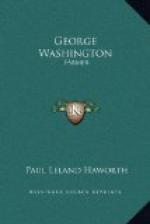One of the sights to-day at Mount Vernon is the formal garden, which all who have visited the place will remember. Strangely enough it seems impossible to discover exactly when this was laid out as it now stands. The guides follow tradition and tell visitors that Washington set out the box hedge, the principal feature, after his marriage, and that he told Martha that she should be mistress of this flower garden and he the master of the vegetable garden. It is barely possible that he did set out the hedges at that time, but, if so, it must have been in 1759, for no mention is made of it in the diary begun in 1760. In April, 1785, we find by his diary that he planted twelve cuttings of the “tree box” and again in the spring of 1787 he planted in his shrubberies some holly trees, “also ... some of the slips of the tree box.” But of box hedges I can find no mention in any of the papers I have seen. One guess is about as good as another, and I am inclined to believe that if they were planted in his time, it was done during his presidency by one of his gardeners, perhaps Butler or the German, Ehler. They may have been set out long after his death. At all events the garden was modeled after the formal gardens of Europe and the idea was not original with him.
East of the formal garden lies a plot of ground that he used for agricultural experiments. The vegetable garden was south of the Bowling Green and separated from it by a brick wall. Here utility was lord and a great profusion of products was raised for the table. Washington took an interest in its management and I have found an entry in his diary recording the day that green peas were available for the first time that year. Evidently he was fond of them.
The bent of our Farmer’s mind was to the practical, yet he took pride in the appearance of his estate. “I shall begrudge no reasonable expense that will contribute to the improvement and neatness of my farms,” he wrote one of his managers, “for nothing pleases me better than to see them in good order, and everything trim, handsome, and thriving about them; nor nothing hurts me more than to find them otherwise.”
Live hedges tend to make a place look well and it was probably this and his passion for trees that caused Washington to go in extensively for hedges about his farms. They took the place of wooden fences and saved trees and also grew more trees and bushes. His ordinary course in building a fence was to have a trench dug on each side of the line and the dirt thrown toward the center. Upon the ridge thus formed he built a post and rail fence and along it planted cedars, locusts, pines, briars or thorn bushes to discourage cattle and other stock. The trenches not only increased the efficiency of the fence but also served as ditches. In many places they are still discernible. The lines of the hedges are also often marked in many places by trees which, though few or none can be the originals, are descended from the roots or seeds of those trees. Cedar and locust trees are particularly noticeable.




